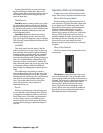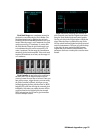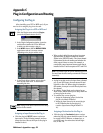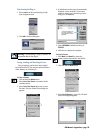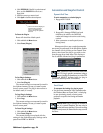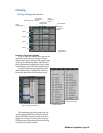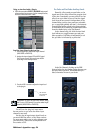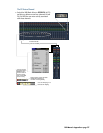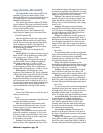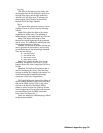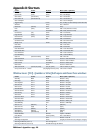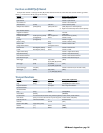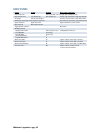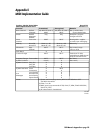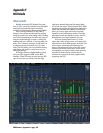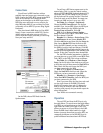D8B Manual • Appendices • page 158
Using the Mackie Effects (MFX)
The Digital 8•Bus comes with one MFX card
installed to provide two stereo effects. Three
additional MFX cards can be installed for a total of
up to eight mono-in, stereo-out internal effects
available simultaneously.
The console ships with the Mackie FX (MFX)
plug-in installed. This plug-in provides five useful
effects that can be globally selected and used with
the aux sends and FX returns.
Each effect has a 3-Band Parametric EQ
which filters the signal prior to the actual effect.
3-Band Parametric EQ
Click the EQ button in the lower right corner
of the Mackie Effects window to turn the EQ on
and off. This provides a low-shelving filter with a
corner frequency at 100 Hz, a mid-band fully
parametric EQ, and a high-shelving filter with a
corner frequency at 10 kHz.
Click the EDIT button to change the EQ
parameters.
Low Shelf Gain: This adjusts the boost and cut
below 100 Hz. This is calibrated in decibels (dB),
with a range from –12 dB to +12 dB.
High Shelf Gain: This adjusts the boost and
cut above 10kHz. This is calibrated in decibels
(dB), with a range from –12 dB to +12 dB.
Mid Gain: This adjusts the boost and cut at
the mid-frequency setting. This is calibrated in
decibels (dB), with a range from –12 dB to +12 dB.
Mid Frequency: This adjusts the center
frequency of the parametric EQ. This is calibrated
in Hertz (Hz), with a range from 100 Hz to 10 kHz.
Mid Q: This adjusts the bandwidth of the
frequencies affected by the parametric EQ. It is a
unit-less measure, with a range from 0.1 to 10. A
low Q setting provides a very tight bandwidth (less
than an octave), and a high Q setting provides a
very wide bandwidth (covering several octaves).
Effects Type
Click on the TYPE control to select the type of
effect you want to use.
Reverb
This uses a room reverberation algorithm that
provides the following controls:
Size: This adjusts the time between reflec-
tions to simulate different room sizes. It is cali-
brated in meters (m), with a range from 3.0 m
(small) to 40.0 m (large).
Decay: This adjusts the amount of time that
reflections continue to propagate. A “live” room
will have a longer decay time than a “dead” room.
It is calibrated in seconds (s), with a range from
0.9 seconds to 2.0 seconds.
PreDelay: This adjusts the amount of delay
between the dry audio signal and the start of the
wet reverberant signal. Adjusting this control can
provide better separation and definition to the dry
signal. It is calibrated in milliseconds (ms), with a
range from 0 ms to 299 ms (0.3 seconds).
Diffusion: This controls the increase in echo
density over time in the reverberant signal. The
higher the diffusion setting, the higher the echo
density. This is a unit-less measure, with a range
from 0 to 10.
Damping: This control causes the higher
frequencies to roll off faster than the low frequen-
cies. The higher the damping setting, the faster
the high frequencies roll off. This is a unit-less
measure, with a range from 0 to 10.
Rolloff: This adjusts the cutoff frequency for
rolling off the entire reverberant signal. This is
different from the damping control which rolls off
only the higher frequencies over time. It is cali-
brated in Hertz (Hz), with a range from 500 Hz to
20 kHz. It also has a Flat position, which bypasses
the control.
Mono Delay
The mono delay effect provides an adjustable
delay, which is returned to the left and right stereo
effect return. It also provides an adjustable
feedback path for a multiple echo effect. The mono
delay has the following controls:
Delay: This adjusts the amount of time
between the original signal and the delayed signal.
It is calibrated in milliseconds (ms), with a range
from 0 ms to 1599 ms (1.6 seconds).
Feedback: This adjusts the amount of signal
that is fed back to the input of the delay. It is
calibrated in percent, with a range from 0% to 99%.
Rolloff: This adjusts the cutoff frequency for
rolling off the feedback signal. It is calibrated in
Hertz (Hz), with a range from 500 Hz to 20 kHz. It
also has a Flat position, which bypasses the control.
Stereo Delay
The stereo delay effect provides independently
adjustable delays which are returned to the left
and right stereo effect return. It also provides an
adjustable feedback path for a multiple echo
effect. The stereo delay has the following controls:
Left and Right Delay: This adjusts the amount
of time between the original signal and the
delayed signal. It is calibrated in milliseconds
(ms), with a range from 0 ms to 799 ms (0.8
seconds). Notice that the stereo delay effect has
precisely one-half the amount of delay available
per channel as the mono delay.
Left and Right Feedback: This adjusts the
amount of signal that is fed back to the input of
the delay. It is calibrated in percent, with a range
from 0% to 99%.
Rolloff: This adjusts the cutoff frequency for
rolling off the feedback signal. It is calibrated in
Hertz (Hz), with a range from 500Hz to 20kHz. It
also has a Flat position, which bypasses the control.



